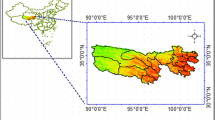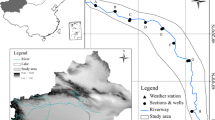Abstract
Because of long-term stream-flow cut off in the lower reaches of Tarim River, environmental degradation has become the most severe and widespread environmental problem in Tarim River basin. Nine ecological water conveyances to the lower reaches of Tarim River made ecological environment change a lot. 3S technology was used to monitor dynamic change of ecology. However, remote sensing area index cannot analyze ecological restoration degree of Tarim River precisely because the time of each water conveyance is short, the change of vegetation area is not obvious, and there exists visual interpretation error. In this paper, remote monitoring datum of high temporal resolution and high spatial resolution were used to research the relationships between normalized difference vegetation index (NDVI) and the groundwater depth, between NDVI and the surface vegetation coverage, and between the groundwater depth and the surface vegetation coverage. The growth and restoration of the vegetation in different periods were evaluated by investigative analysis of the change trend of NDVI. The conception of relative restoration degree was proposed and the response of vegetation restoration to the water conveyance was evaluated. The evaluation result suggests that: first, the response of vegetation to the water conveyance concentrates within 1,000 m of both riversides, and the range of influence becomes smaller along the lower reaches of Tarim River. Second, influenced by the groundwater recharge, the vegetation coverage shows decreasing trend with the increase of off-river distance. Third, the vegetation coverage shows decreasing trend along the watercourse influenced by the water consumption. Finally, in spatial, original scattered meadow of low coverage transforms to high coverage gradually in research region. Vegetation response to the water conveyance expands to both sides with the watercourse being the axis, and expanding scale increases continuously.










Similar content being viewed by others
References
Alexander MH, Shane WC, Michael LR (2003) The use of time-integrated NOAA NDVI data and rainfall to assess landscape degradation in the arid shrubland of Western Australia. Remote Sens Environ 85:145–158
Chen YJ, Li WH, Chen YN, Liu JZ, He B (2007) Ecological effect of synthesized governing in Tarim River valley. China Environ Sci 27(1):24–28
Chen YJ, Zhou KF, Chen YN, Li WH, Liu JZ, Tao W (2008) Response of groundwater chemistry to water deliveries in the lower reaches of Tarim River, Northwest China. Environ Geol 53:1365–1373
Deng MJ (2005) Eco-environmental responses of the lower reaches of Tarim River to the emergency water deliveries. Adv Water Sci 16(4):586–591
Enrico F, Laura GV, Woldu Z (2002) Evaluation of environmental degradation in northern Ethiopia using GIS to integrate vegetation, geomorphological, erosion and socio-economic factors. Agric Ecosyst Environ 91:313–325
Gong XM, Ma Y, Gui DW, Yuan ZY, Lv GH (2007) The ecological fragility appraisal of the natural meadow in a typical basin of arid area. J Chengdu University Technol (Science & Technology Edition) 34(2):216–220
Guo K, Sun PX, Liu WG (2005) Abstracting vegetation index from remote sensing images using ERDAS IMEGINE. West China Explor Eng 109(6):210–212
Jeremy LW, David SG, AC JuliaE, Clifford ND (2004) Long-term vegetation monitoring with NDVI in a diverse semi-arid setting, central New Mexico, USA. J Arid Environ 58:249–272
Li X, Hou P, Dong XG, Zhu XH (2005) Vegetation restoration after emergent water conveyance to lower reaches of Tarim River. Chin J Ecol 24(12):1449–1453
Li JC, Li X, Chen JF, Wang JG (2007) The difference of analyses Populus euphratica’s tree ring growth before water transport and after water transport in the lower reaches of Tarim River. Ecol Environ 16(1):125–129
Liu H, Chen YN, Yang XM (2007) Monitor of ecological response along lower reaches of Tarim River based on remote sensing. Arid Land Geogr 30(2):204–208
Ruan X, Wang Q, Chen YN, Li WH, Xu NY (2005) Physiological response of desert plants to watering in hyper arid area of Tarim River. Acta Ecol Sinica 25(8):1966–1973
Su LC, Deng ZB (2005) Construction of digital groundwater depth model for lower Tarim River. J Hehai University (Natural Sciences) 33(1):45–48
Sun W, Hou P, Li X (2006) Increment in branch diameter of Populus euphratica in response to emergent water transportation to downstream Tarim River, China. Acta Ecol Sinica 26(9):2913–2917
Xing Q, Liu AJ, Liu YZ (2005) Study on change rangeland vegetation, change using MODIS-NDVI in Xilinguole grassland. Acta Agrestia Sinica 13(supplement):15–19
Xu HL, Ye M, Song YD (2007) The natural vegetation responses to the groundwater change resulting from ecological water conveyances to the lower Tarim River. Environ Monit Assess 131:37–48
Yang PN, Zhang SJ, Dong XG (2007) Study on the characteristics of water conversion after conveying stream water to the lower reaches of Tarim River for regenerating the ecology. Arid Zone Res 24(2):174–178
Ye ZX, Chen YN, Li WH (2007) The general appraisement of groundwater level after ecological water transportation in the lower reaches of Tarim River. J Arid Land Resour Environ 21(8):12–16
Zhang H, Wu JW, Zheng QH, Yu YJ (2003) A preliminary study of oasis evolution in the Tarim Basin, Xinjiang, China. J Arid Environ 55:545–553
Acknowledgments
This work was supported by Ministry of Water Resources P. R. China 948 science and technology initiative item under Grant SCX2005-02, the ‘Research of Tarim River Ecological Water Conveyances and ecology Restoration’. Authors especially thank the anonymous reviewers who read a first draft of this paper for their constructive comments to further improve the manuscript.
Author information
Authors and Affiliations
Corresponding author
Rights and permissions
About this article
Cite this article
Wu, J., Tang, D. The influence of water conveyances on restoration of vegetation to the lower reaches of Tarim River. Environ Earth Sci 59, 967–975 (2010). https://doi.org/10.1007/s12665-009-0090-9
Received:
Accepted:
Published:
Issue Date:
DOI: https://doi.org/10.1007/s12665-009-0090-9




